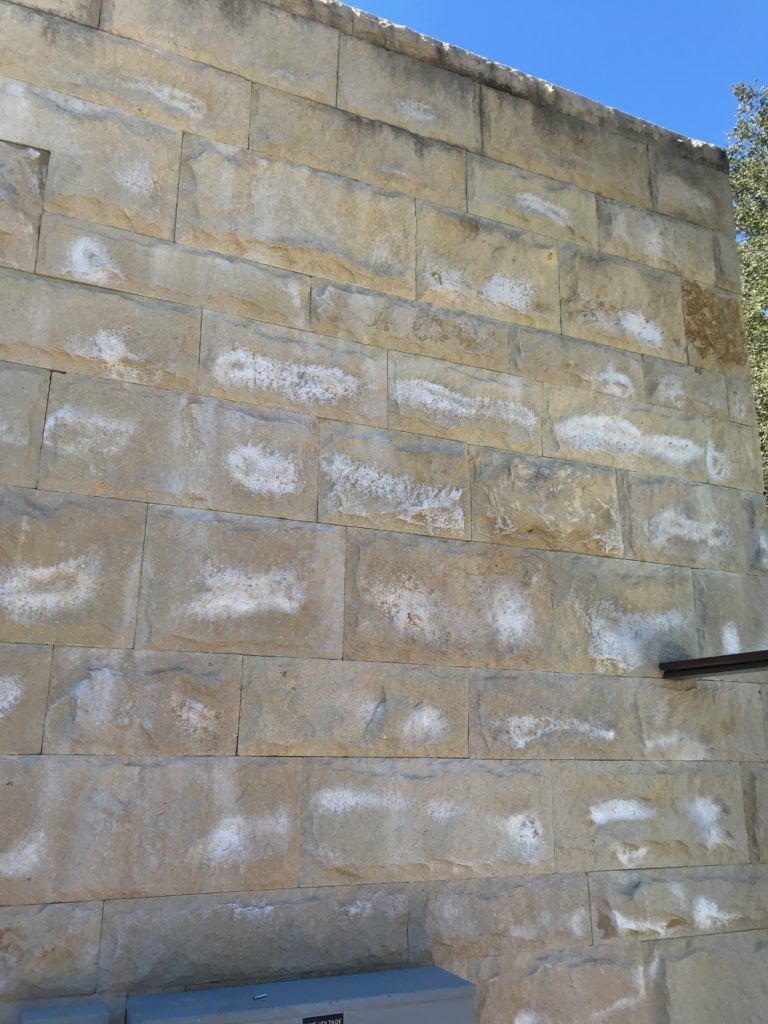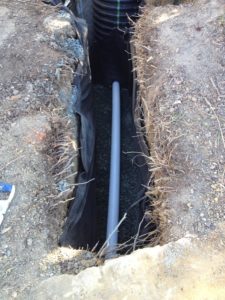Dealing with Efflorescence on Masonry Surfaces
Efflorescence is a white powdery looking substance that will sometimes appear on stone, concrete or tile surfaces. This shows up as irregular, whitish blotches and is especially frequent around joints and grout lines. All masonry is susceptible to efflorescence and it is an ugly and unwelcome flaw.

Unseen moisture is the problem.
Efflorescence happens when moisture becomes saturated with minerals and salt as it travels through a masonry material. When the moisture reaches the surface, it leaves behind the minerals as it evaporates. This is the unattractive whitish looking deposit on the finish.
I have seen this problem occur on both flat surfaces or vertical walls. And it can even happen when no obvious moisture is apparent. In fact, you may never see the moisture actually causing the problem because it is likely buried deep within the material.
Capillary action
“Travelling” is not really the right term to describe what the moisture is doing. Capillary action actually draws moisture to the surface with a very strong force. This movement happens because water tends to be attracted to, and migrate towards drier places. It also will “wick” vertically to great heights through small cracks or tubes. Capillary action is powerful enough that trees use it to pull moisture from the roots all the way up to the leaves. On some trees that’s a journey of perhaps 200-300’.
Prevention
The best way to avoid this problem (as usual) is to prevent it from happening. You do this by using capillary breaks and moisture barriers directly beneath any concrete or mortar base material. It can also help if you use materials with low salt or mineral content. Use low amounts of water in the concrete or mortar mixes and allow them to dry appropriately before installing the finish materials.
Also incorporate good drainage to eliminate water getting to the underside, backside or interior of concrete slabs or masonry walls. For exterior walls, drainage space and weep holes must be provided so that any water getting into the interior or backside of the masonry can escape out the bottom. Waterproof flashing or cap material should be installed along the top of any exposed walls. This will shed water off and help prevent it from soaking into the center of the wall.
The bottom line: to reduce the risk of efflorescence on exterior surfaces, excellent drainage and moisture protection needs to be designed and built into the system right from the start.
Repair is difficult
Efflorescence is very difficult to correct. It is often too late once it is noticed. In some ultra-rare cases, the moisture causing the problem will evaporate completely. If it does, some scrubbing with a stiff brush and muriatic acid will remove the spots. Unfortunately, the condition almost always returns. In dealing with efflorescence eliminating moisture is key to ensuring the problem will not recur.
To stop the problem the moisture source must be eliminated and the masonry allowed to dry. Only then can the surface deposits be cleaned off permanently.
Retaining walls
If efflorescence is showing up on vertical retaining walls, you will need to excavate behind the entire height of the wall, install a moisture barrier on the backside of the wall, then install an interceptor drain system to keep any moisture from making its way to the surface of the wall. An interceptor drain system (sometimes called a burrito drain) consists of perforated drain pipe at the bottom of the system, surrounded by clean drain rock and completely wrapped by a layer of filter fabric. Concrete block walls with voids filled with high-moisture grout can cause efflorescence problems for years till the grout fully cures.

Vertical exterior walls
Dealing with efflorescence showing up on exterior masonry walls (as pictured above) takes a different approach. First the moisture may be residual from the building process i.e. it is trapped inside the wall. If that is the case, you may just need to wait it out while the moisture dries and works its way out. After a few years you can clean up the exterior, seal the surface and you should be good. Sealing the surface is important because rain can soak the exterior and allow water to penetrate deeply into the surface and cause problems again. The top of any exposed masonry walls should be capped with metal flashing to prevent water penetration and to help shed rain away from the surfaces. Prevent irrigation from spraying on the surface of any walls.
Patio surfaces
If a white powder on masonry is appearing on flat patio surfaces, it almost always indicates the lack of a capillary break system under the surface. Unfortunately, the only way to remedy this situation is to remove the patio and install one. A proper capillary break is mandatory, especially when the patio is built over clay or hardpan soil that does not drain well. Sorry… I told you it would be difficult. If you do not install some type of capillary break under or behind the system, the moisture will want to migrate through to the surface causing the problem again. The capillary break provides any moisture an escape route away from, rather than through the finished surface.
Help me to help you
Thank you for taking time to use this free website. I hope you find the junk-free information here fun and useful? Please send me your comments and feedback. Writing and maintaining this site is a lot of hard work. By sharing these pages with your friends, you help me to continue the effort. You can easily share these pages to all your favorite social media sites via the shortcut buttons on the sidebar. You can also simply email the page link to your friends. Please share often.
The very best way to help me occurs when you use the embedded links to buy things. Using a link is easy and free, yet it provides a great source of support for this site. The vendors I’ve chosen to link to have proven to be the very best resources available so that is why I recommend them personally.
This is the place to visit if you want information on: How to improve air quality; ways to improve the value of your home; what are the best cleaning services; do you really need handyman services; how to plan and execute home renovation and home improvement projects; ways to hire a handyman; what to do during spring cleaning; ways to go about tidying up a messy house; and generally how to be a better homeowner.
Make sure you download your monthly maintenance checklist for this month.
If you have questions or just want to say hi, please send me a note. If you are looking for help performing the work described and you are in the San Francisco area, go to HPS Palo Alto Inc. and request a free evaluation.
Thank you!
Copyright and permission to use information.
It is unlawful to make copies including cut and paste or especially in the form of making printouts for personal use. If you wish to make a print for personal use, I will happily grant you one-time permission if you will kindly send me a request in writing.




